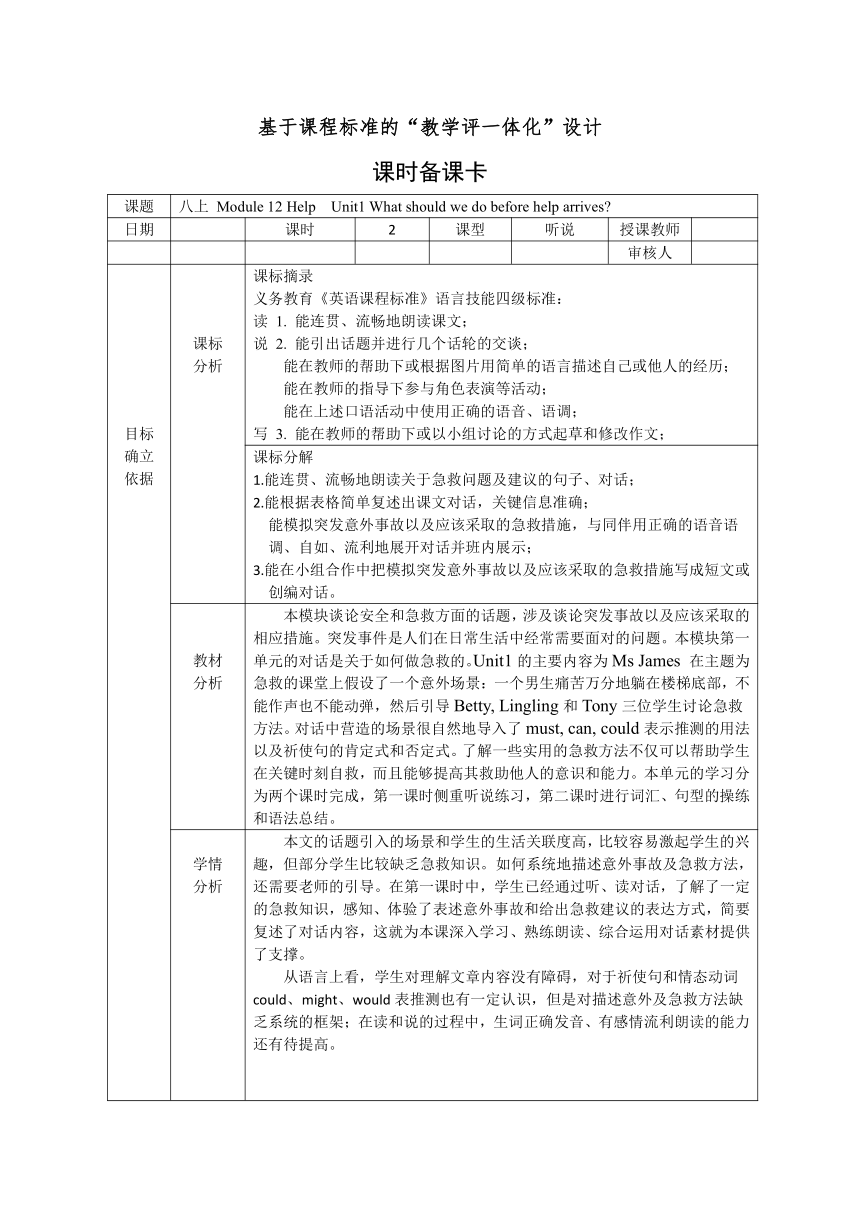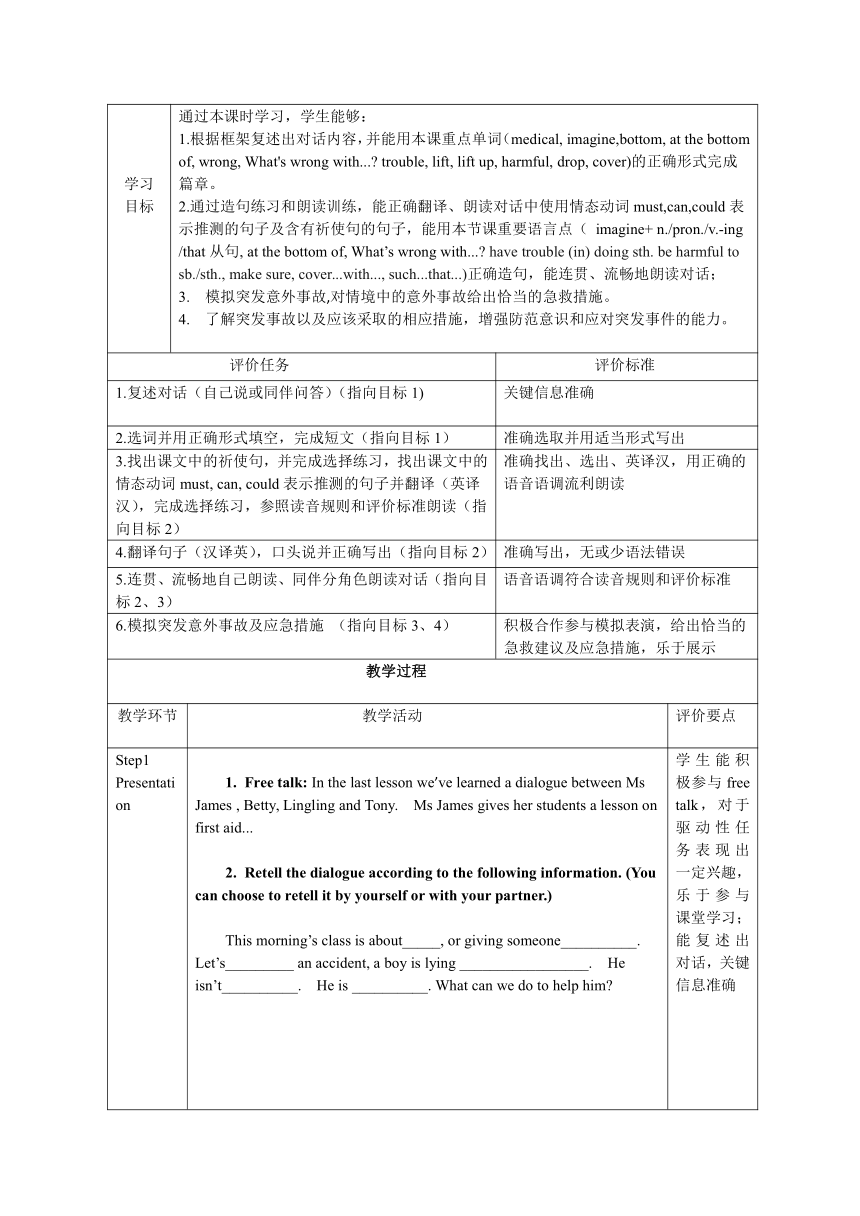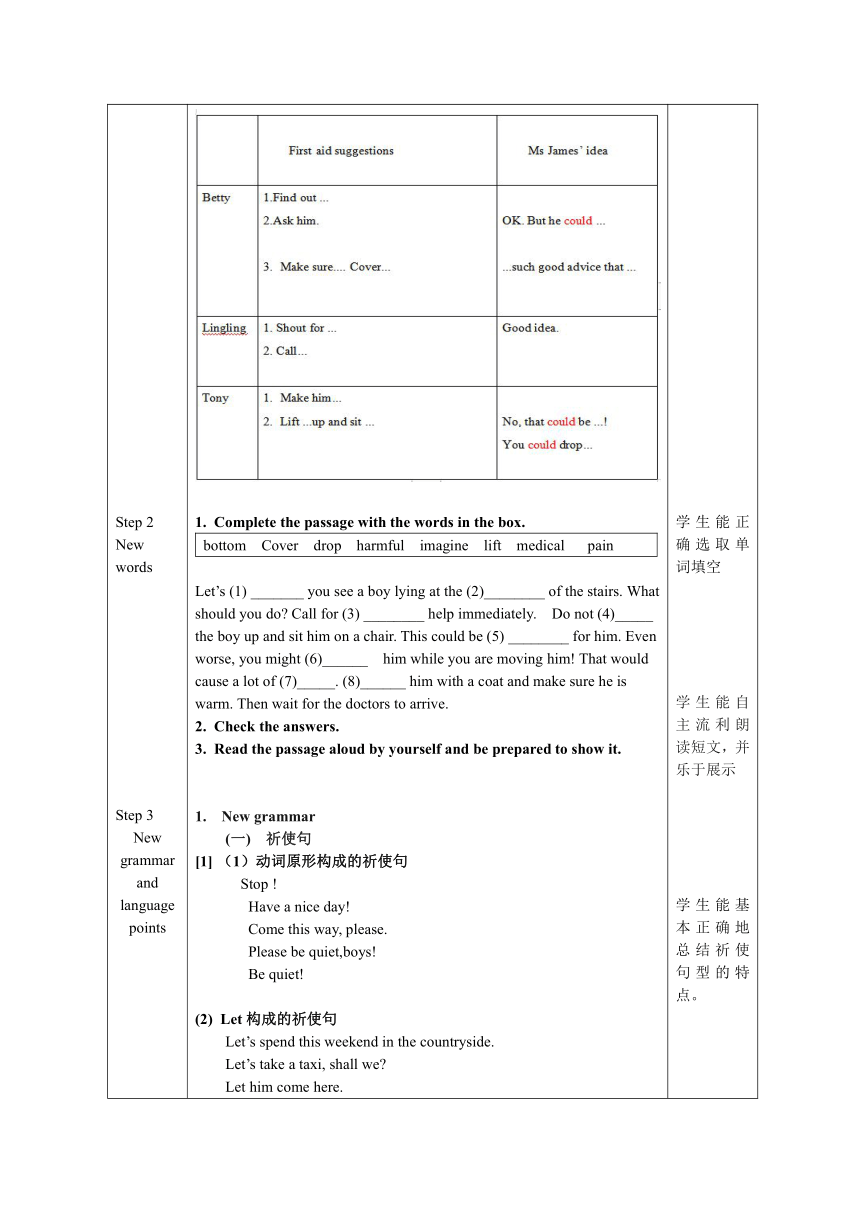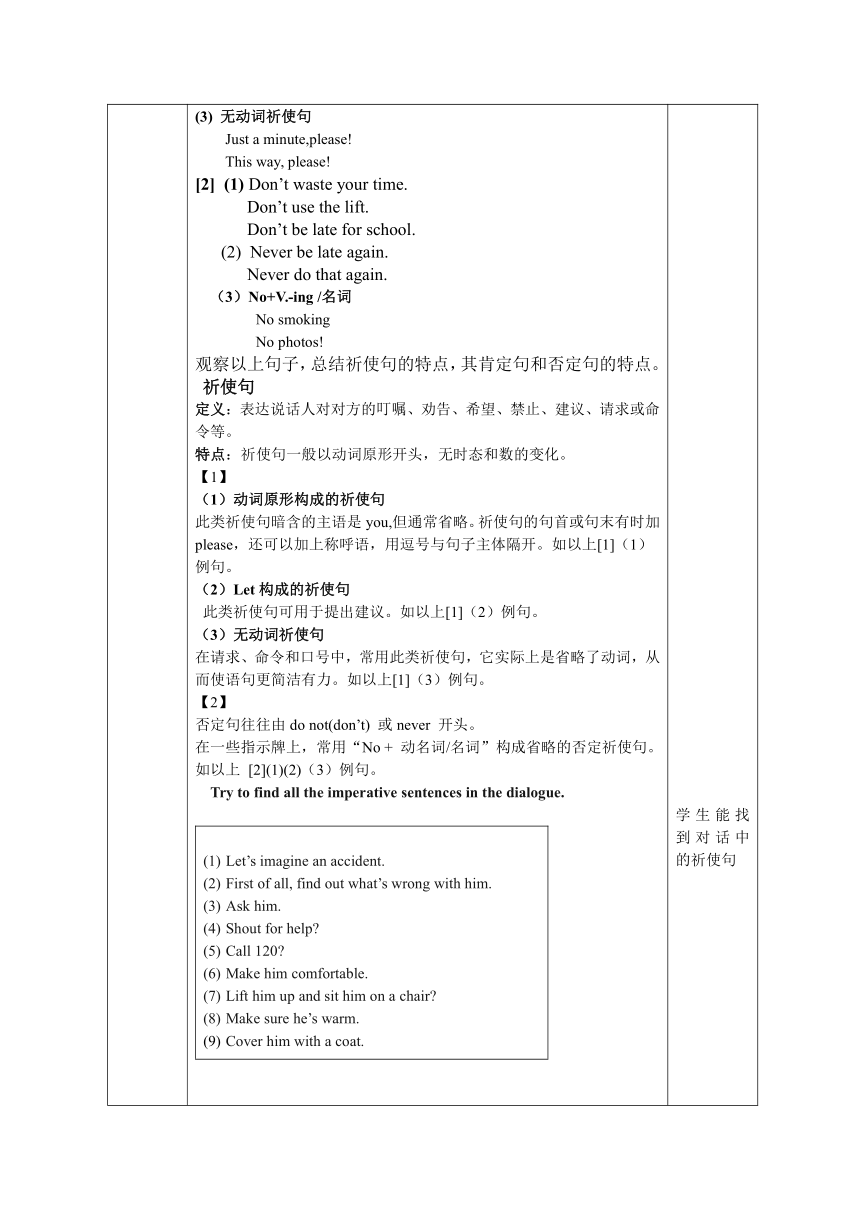外研版八年级英语上册 英语Module 12 Help Unit 1课时备课卡(表格式)
文档属性
| 名称 | 外研版八年级英语上册 英语Module 12 Help Unit 1课时备课卡(表格式) |  | |
| 格式 | docx | ||
| 文件大小 | 404.5KB | ||
| 资源类型 | 教案 | ||
| 版本资源 | 外研版 | ||
| 科目 | 英语 | ||
| 更新时间 | 2022-08-17 08:23:11 | ||
图片预览




文档简介
基于课程标准的“教学评一体化”设计
课时备课卡
课题 八上 Module 12 Help Unit1 What should we do before help arrives
日期 课时 2 课型 听说 授课教师
审核人
目标 确立 依据 课标 分析 课标摘录 义务教育《英语课程标准》语言技能四级标准: 读 1. 能连贯、流畅地朗读课文; 说 2. 能引出话题并进行几个话轮的交谈; 能在教师的帮助下或根据图片用简单的语言描述自己或他人的经历; 能在教师的指导下参与角色表演等活动; 能在上述口语活动中使用正确的语音、语调; 写 3. 能在教师的帮助下或以小组讨论的方式起草和修改作文;
课标分解 1.能连贯、流畅地朗读关于急救问题及建议的句子、对话; 2.能根据表格简单复述出课文对话,关键信息准确; 能模拟突发意外事故以及应该采取的急救措施,与同伴用正确的语音语调、自如、流利地展开对话并班内展示; 3.能在小组合作中把模拟突发意外事故以及应该采取的急救措施写成短文或创编对话。
教材 分析 本模块谈论安全和急救方面的话题,涉及谈论突发事故以及应该采取的相应措施。突发事件是人们在日常生活中经常需要面对的问题。本模块第一单元的对话是关于如何做急救的。Unit1的主要内容为Ms James 在主题为急救的课堂上假设了一个意外场景:一个男生痛苦万分地躺在楼梯底部,不能作声也不能动弹,然后引导Betty, Lingling和Tony三位学生讨论急救方法。对话中营造的场景很自然地导入了must, can, could表示推测的用法以及祈使句的肯定式和否定式。了解一些实用的急救方法不仅可以帮助学生在关键时刻自救,而且能够提高其救助他人的意识和能力。本单元的学习分为两个课时完成,第一课时侧重听说练习,第二课时进行词汇、句型的操练和语法总结。
学情 分析 本文的话题引入的场景和学生的生活关联度高,比较容易激起学生的兴趣,但部分学生比较缺乏急救知识。如何系统地描述意外事故及急救方法,还需要老师的引导。在第一课时中,学生已经通过听、读对话,了解了一定的急救知识,感知、体验了表述意外事故和给出急救建议的表达方式,简要复述了对话内容,这就为本课深入学习、熟练朗读、综合运用对话素材提供了支撑。 从语言上看,学生对理解文章内容没有障碍,对于祈使句和情态动词could、might、would表推测也有一定认识,但是对描述意外及急救方法缺乏系统的框架;在读和说的过程中,生词正确发音、有感情流利朗读的能力还有待提高。
学习 目标 通过本课时学习,学生能够: 1.根据框架复述出对话内容,并能用本课重点单词(medical, imagine,bottom, at the bottom of, wrong, What's wrong with... trouble, lift, lift up, harmful, drop, cover)的正确形式完成篇章。 2.通过造句练习和朗读训练,能正确翻译、朗读对话中使用情态动词must,can,could表示推测的句子及含有祈使句的句子,能用本节课重要语言点( imagine+ n./pron./v.-ing /that从句, at the bottom of, What’s wrong with... have trouble (in) doing sth. be harmful to sb./sth., make sure, cover...with..., such...that...)正确造句,能连贯、流畅地朗读对话; 3. 模拟突发意外事故,对情境中的意外事故给出恰当的急救措施。 4. 了解突发事故以及应该采取的相应措施,增强防范意识和应对突发事件的能力。
评价任务 评价标准
1.复述对话(自己说或同伴问答)(指向目标1) 关键信息准确
2.选词并用正确形式填空,完成短文(指向目标1) 准确选取并用适当形式写出
3.找出课文中的祈使句,并完成选择练习,找出课文中的情态动词must, can, could表示推测的句子并翻译(英译汉),完成选择练习,参照读音规则和评价标准朗读(指向目标2) 准确找出、选出、英译汉,用正确的语音语调流利朗读
4.翻译句子(汉译英),口头说并正确写出(指向目标2) 准确写出,无或少语法错误
5.连贯、流畅地自己朗读、同伴分角色朗读对话(指向目标2、3) 语音语调符合读音规则和评价标准
6.模拟突发意外事故及应急措施 (指向目标3、4) 积极合作参与模拟表演,给出恰当的急救建议及应急措施,乐于展示
教学过程
教学环节 教学活动 评价要点
Step1 Presentation Step 2 New words Step 3 New grammar and language points Step4 Learning for use Step 5 Summary: Step 6 Homework Free talk: In the last lesson we’ve learned a dialogue between Ms James , Betty, Lingling and Tony. Ms James gives her students a lesson on first aid... Retell the dialogue according to the following information. (You can choose to retell it by yourself or with your partner.) This morning’s class is about_____, or giving someone__________. Let’s_________ an accident, a boy is lying _________________. He isn’t__________. He is __________. What can we do to help him Complete the passage with the words in the box. bottom Cover drop harmful imagine lift medical pain
Let’s (1) _______ you see a boy lying at the (2)________ of the stairs. What should you do Call for (3) ________ help immediately. Do not (4)_____ the boy up and sit him on a chair. This could be (5) ________ for him. Even worse, you might (6)______ him while you are moving him! That would cause a lot of (7)_____. (8)______ him with a coat and make sure he is warm. Then wait for the doctors to arrive. Check the answers. Read the passage aloud by yourself and be prepared to show it. New grammar 祈使句 (1)动词原形构成的祈使句 Stop ! Have a nice day! Come this way, please. Please be quiet,boys! Be quiet! Let构成的祈使句 Let’s spend this weekend in the countryside. Let’s take a taxi, shall we Let him come here. 无动词祈使句 Just a minute,please! This way, please! (1) Don’t waste your time. Don’t use the lift. Don’t be late for school. Never be late again. Never do that again. (3)No+V.-ing /名词 No smoking No photos! 观察以上句子,总结祈使句的特点,其肯定句和否定句的特点。 祈使句 定义:表达说话人对对方的叮嘱、劝告、希望、禁止、建议、请求或命令等。 特点:祈使句一般以动词原形开头,无时态和数的变化。 【1】 (1)动词原形构成的祈使句 此类祈使句暗含的主语是you,但通常省略。祈使句的句首或句末有时加please,还可以加上称呼语,用逗号与句子主体隔开。如以上[1](1)例句。 (2)Let构成的祈使句 此类祈使句可用于提出建议。如以上[1](2)例句。 (3)无动词祈使句 在请求、命令和口号中,常用此类祈使句,它实际上是省略了动词,从而使语句更简洁有力。如以上[1](3)例句。 【2】 否定句往往由do not(don’t) 或never 开头。 在一些指示牌上,常用“No + 动名词/名词”构成省略的否定祈使句。 如以上 [2](1)(2)(3)例句。 Try to find all the imperative sentences in the dialogue. Let’s imagine an accident. First of all, find out what’s wrong with him. Ask him. Shout for help Call 120 Make him comfortable. Lift him up and sit him on a chair Make sure he’s warm. Cover him with a coat.
Exercise: Please______here earlier! We don’t want to miss the last bus to the library. arrive B. to arrive C. arriving Tommy, ______ play basketball in the street next time.You may get hurt by a car. do B. don’t C. must D. mustn’t (二)情态动词must, can, could表示推测 我们学习过情态动词can和could表示“能够,可以”等意义的用法除此之外,can和could还可以表示对现在或将来的推测,意为“会,可能”。 (1)can表推测时,往往用于否定句和疑问句。用于疑问句时,can比could表示的“可能性”要大;用于否定句时,cannot (can’t) 表示“不可能”。 如:You can’t be serious! 你不是认真的吧! That can’t be the right road. 这不可能是正确的路。 (2)could则可用于肯定句、否定句和疑问句。 在以下例句中,can和could均表示可能: 如:He could be in pain.他可能很疼。 That could be harmful!那可能有害! Can/Could this be true 这有可能是真的吗? (3)情态动词must也可以表示猜测,意为“一定,准是”,通常只用于肯定句,表示有把握的推测. 如: Betty, you must know!贝蒂,你肯定知道! It must be your brother. I saw him in your room just now.肯定是你哥哥,我刚才看见他在你的房间里。 Try to find the sentences with can,could,must for prediction in the dialogue, and translate them into Chinese. But he could have trouble hearing you or speaking to you. No, that could be harmful! You could drop him and hurt him even more. Betty, you must know.
Exercise: (1)------ Is that Tom over there -------It______be him. He is on the plane to Chengdu now. can’t be B. might not C. must (2)------ Do you know whose book it is ------- It______ be Lily’s. Look! Her name is on the cover. may B. can’t C. must New language points: Translate the following sentences into English. 1)imagine (v.) 想象,设想 imagine+ n./pron./v.-ing /that从句 (1)让我们想象一起事故。【课本原句】 (2)我们可以想象一下没有水的生活。 (3)这房子正是她所想象的。 (4)我想象着和朋友们玩耍(的样子)。 (5)闭上眼睛,设想自己在森林里。 2)at the bottom of 在...的底部 (1)一个男孩正躺在楼梯的底部。【课本原句】 (2)河底有许多沙子。(sand [U]) (3) 我在山脚下等候他们。 (4)花园尽头有一条河。 (5)我在位于我们那条街尽头的学校上学。 3)What’s wrong with... ...怎么了? = What’s the matter with... =What happened to ... (1)首先,弄清楚他怎么了。【课本原句】 (2)你怎么了? (3) 她怎么了? (4)他们怎么了? (5)你的电脑怎么了 4)have trouble (in) doing sth. 做某事有困难 trouble[U] 问题,麻烦,困难 【拓展】have trouble with sth. 在...方面有困难 I had trouble with English last year. (1)但是他有可能难以听到你(说话)或者和你说话。【课本原句】 (2)玛丽学英语有困难。 (3)我在理解这个新单词方面有困难。你能帮助我吗? (4)我在学弹钢琴方面有困难。 (5)我和外国人交流有困难。 5)be harmful to sb./sth.对某人/某物有害 (1)不行,那可能会造成伤害!【课本原句】 (2)你知道它是有害的吗 (3)吸烟对你的健康有害。 (4)不要整天在电脑上玩游戏,它对你的眼睛有害。 (5)果汁可能损害儿童的牙齿。 6)make sure 确保,确信 make sure that从句 make sure of (1)确保他不受凉。【课本原句】 (2)在出门之前一定要把所有的灯都关掉。 (3)确保不要让任何人发觉这件事。 (4)我们又进了一个球,这就赢定了。(score another goal; victory) (5) 确保大家是安全的。 7) cover... with... 把...盖在...上 【拓展】be covered with被...覆盖,表示状态 The ground was covered with snow. (1)确保他不受凉。把外套盖在他身上。【课本原句】 (2)她用双手捂住了脸。 (3)在桌子上铺一块布。 (4)他在书桌上铺了些报纸。 (5) 风把一切都蒙上了一层沙子。 8) such...that... 如此...以至于... such是形容词,后面要接名词(短语) such后面接名词,名词前可以有形容词修饰。如果只有形容词或副词,则要使用 so ... that ... 这一句型。 如: It is such a tiny kitchen that only one person can cook in it. They are such nice people that we all like them. He was so weak that he could hardly stand up. Everything happened so quickly that I hadn’t time to think. 辨析:such + a/an + 可数名词单数+ that 从句 such + 可数名词复数/不可数名词 + that 从句 so + adj./adv. + that 从句 so + adj. + a/an + 可数名词单数 + that从句 如: It’s such a good book that every student likes it. They are such nice girls that we all like them. That’s such good advice that you could be a doctor,Betty. He is so young that he can’t go to school. It is so exciting a film that everyone likes to see it. 注意:如果名词前有many,much,few 或little 修饰时,要用so...that...,不能用such...that... 如:There are so many beautiful skirts that she can’t decide which one to choose. (1)这个建议非常好,贝蒂,你都可以当医生了。【课本原句】 (2)天气如此冷,以至于街上没有一个人。 (3)他是一个如此聪明的男孩以至于我们都喜欢他。 (4)这是如此有趣的一本书以至于每个学生都喜欢读。 (5)她说话如此大声,以至于大家都能听见。 3. Read aloud: (1) Read the whole dialogue aloud by yourself. (2) Read in roles with your group members. (3) Act it out. (Pay attention to the tips) 读音规则停顿①并列句、复合句中,连词前要停顿 ②不同意群间要停顿 ③速度适中,有一定的节奏感重音一般来说,介词、连词、冠词、人称代词不重读(需要强调时也重读),其他词都重读连读①“辅音+元音”要连读 ② 相同辅音连缀要省读前一个语调一般疑问句用上扬语调,特殊疑问句用下沉语调情感情感色彩把握准确,注意模仿人物语气
评价规则完整度 失分点①短语、句子未读完 ②漏词、跳词流畅度 失分点①语调不准确 ②未正确在意群间进行停顿 ③生难词卡顿准确度 失分点①加音或吞音 ②重音错位 ③辅音不准确,或元音不准确、不饱满情感表达 失分点情感不饱满,语调语气不符合人物特点
Our school is going to hold a competition on first aid knowledge next Friday. We should get ready for it now. Discussion: Work in groups and discuss with your partner. What can you do to help them Can you give some first aid advice sunstroke[ s nstr k]中暑 情感升华: Accidents are everywhere. Safety is important! It is necessary to learn about first aid so that we can help ourselves as well as others when accidents happen. Try to imitate the dialogue after the e-pen/recording by yourself. Choose one of them to finish: Write down your first aid advice for the accidents above. Create a similar dialogue by yourself. Make a poster about preventing accidents at school. 学生能积极参与free talk,对于驱动性任务表现出一定兴趣,乐于参与课堂学习; 能复述出对话,关键信息准确 学生能正确选取单词填空 学生能自主流利朗读短文,并乐于展示 学生能基本正确地总结祈使句型的特点。 学生能找到对话中的祈使句 学生能正确选择 能找到对话中 含有can,could, must 表推测的句子并译成汉语 学生能正确选择 能口头说出并准确写出,无或少语法错误(AB层学生完成5个句子,C层完成3-4个,DE根据情况完成1-2个) 学生能用正确的语音语调和生动饱满的感情展示朗读对话;能基于读音和评价规则互评 积极合作参与模拟表演,给出恰当的急救建议,乐于展示 学生能结合所学及生活实际总结急救建议 ABC层学生能背诵,其他同学熟读
课时备课卡
课题 八上 Module 12 Help Unit1 What should we do before help arrives
日期 课时 2 课型 听说 授课教师
审核人
目标 确立 依据 课标 分析 课标摘录 义务教育《英语课程标准》语言技能四级标准: 读 1. 能连贯、流畅地朗读课文; 说 2. 能引出话题并进行几个话轮的交谈; 能在教师的帮助下或根据图片用简单的语言描述自己或他人的经历; 能在教师的指导下参与角色表演等活动; 能在上述口语活动中使用正确的语音、语调; 写 3. 能在教师的帮助下或以小组讨论的方式起草和修改作文;
课标分解 1.能连贯、流畅地朗读关于急救问题及建议的句子、对话; 2.能根据表格简单复述出课文对话,关键信息准确; 能模拟突发意外事故以及应该采取的急救措施,与同伴用正确的语音语调、自如、流利地展开对话并班内展示; 3.能在小组合作中把模拟突发意外事故以及应该采取的急救措施写成短文或创编对话。
教材 分析 本模块谈论安全和急救方面的话题,涉及谈论突发事故以及应该采取的相应措施。突发事件是人们在日常生活中经常需要面对的问题。本模块第一单元的对话是关于如何做急救的。Unit1的主要内容为Ms James 在主题为急救的课堂上假设了一个意外场景:一个男生痛苦万分地躺在楼梯底部,不能作声也不能动弹,然后引导Betty, Lingling和Tony三位学生讨论急救方法。对话中营造的场景很自然地导入了must, can, could表示推测的用法以及祈使句的肯定式和否定式。了解一些实用的急救方法不仅可以帮助学生在关键时刻自救,而且能够提高其救助他人的意识和能力。本单元的学习分为两个课时完成,第一课时侧重听说练习,第二课时进行词汇、句型的操练和语法总结。
学情 分析 本文的话题引入的场景和学生的生活关联度高,比较容易激起学生的兴趣,但部分学生比较缺乏急救知识。如何系统地描述意外事故及急救方法,还需要老师的引导。在第一课时中,学生已经通过听、读对话,了解了一定的急救知识,感知、体验了表述意外事故和给出急救建议的表达方式,简要复述了对话内容,这就为本课深入学习、熟练朗读、综合运用对话素材提供了支撑。 从语言上看,学生对理解文章内容没有障碍,对于祈使句和情态动词could、might、would表推测也有一定认识,但是对描述意外及急救方法缺乏系统的框架;在读和说的过程中,生词正确发音、有感情流利朗读的能力还有待提高。
学习 目标 通过本课时学习,学生能够: 1.根据框架复述出对话内容,并能用本课重点单词(medical, imagine,bottom, at the bottom of, wrong, What's wrong with... trouble, lift, lift up, harmful, drop, cover)的正确形式完成篇章。 2.通过造句练习和朗读训练,能正确翻译、朗读对话中使用情态动词must,can,could表示推测的句子及含有祈使句的句子,能用本节课重要语言点( imagine+ n./pron./v.-ing /that从句, at the bottom of, What’s wrong with... have trouble (in) doing sth. be harmful to sb./sth., make sure, cover...with..., such...that...)正确造句,能连贯、流畅地朗读对话; 3. 模拟突发意外事故,对情境中的意外事故给出恰当的急救措施。 4. 了解突发事故以及应该采取的相应措施,增强防范意识和应对突发事件的能力。
评价任务 评价标准
1.复述对话(自己说或同伴问答)(指向目标1) 关键信息准确
2.选词并用正确形式填空,完成短文(指向目标1) 准确选取并用适当形式写出
3.找出课文中的祈使句,并完成选择练习,找出课文中的情态动词must, can, could表示推测的句子并翻译(英译汉),完成选择练习,参照读音规则和评价标准朗读(指向目标2) 准确找出、选出、英译汉,用正确的语音语调流利朗读
4.翻译句子(汉译英),口头说并正确写出(指向目标2) 准确写出,无或少语法错误
5.连贯、流畅地自己朗读、同伴分角色朗读对话(指向目标2、3) 语音语调符合读音规则和评价标准
6.模拟突发意外事故及应急措施 (指向目标3、4) 积极合作参与模拟表演,给出恰当的急救建议及应急措施,乐于展示
教学过程
教学环节 教学活动 评价要点
Step1 Presentation Step 2 New words Step 3 New grammar and language points Step4 Learning for use Step 5 Summary: Step 6 Homework Free talk: In the last lesson we’ve learned a dialogue between Ms James , Betty, Lingling and Tony. Ms James gives her students a lesson on first aid... Retell the dialogue according to the following information. (You can choose to retell it by yourself or with your partner.) This morning’s class is about_____, or giving someone__________. Let’s_________ an accident, a boy is lying _________________. He isn’t__________. He is __________. What can we do to help him Complete the passage with the words in the box. bottom Cover drop harmful imagine lift medical pain
Let’s (1) _______ you see a boy lying at the (2)________ of the stairs. What should you do Call for (3) ________ help immediately. Do not (4)_____ the boy up and sit him on a chair. This could be (5) ________ for him. Even worse, you might (6)______ him while you are moving him! That would cause a lot of (7)_____. (8)______ him with a coat and make sure he is warm. Then wait for the doctors to arrive. Check the answers. Read the passage aloud by yourself and be prepared to show it. New grammar 祈使句 (1)动词原形构成的祈使句 Stop ! Have a nice day! Come this way, please. Please be quiet,boys! Be quiet! Let构成的祈使句 Let’s spend this weekend in the countryside. Let’s take a taxi, shall we Let him come here. 无动词祈使句 Just a minute,please! This way, please! (1) Don’t waste your time. Don’t use the lift. Don’t be late for school. Never be late again. Never do that again. (3)No+V.-ing /名词 No smoking No photos! 观察以上句子,总结祈使句的特点,其肯定句和否定句的特点。 祈使句 定义:表达说话人对对方的叮嘱、劝告、希望、禁止、建议、请求或命令等。 特点:祈使句一般以动词原形开头,无时态和数的变化。 【1】 (1)动词原形构成的祈使句 此类祈使句暗含的主语是you,但通常省略。祈使句的句首或句末有时加please,还可以加上称呼语,用逗号与句子主体隔开。如以上[1](1)例句。 (2)Let构成的祈使句 此类祈使句可用于提出建议。如以上[1](2)例句。 (3)无动词祈使句 在请求、命令和口号中,常用此类祈使句,它实际上是省略了动词,从而使语句更简洁有力。如以上[1](3)例句。 【2】 否定句往往由do not(don’t) 或never 开头。 在一些指示牌上,常用“No + 动名词/名词”构成省略的否定祈使句。 如以上 [2](1)(2)(3)例句。 Try to find all the imperative sentences in the dialogue. Let’s imagine an accident. First of all, find out what’s wrong with him. Ask him. Shout for help Call 120 Make him comfortable. Lift him up and sit him on a chair Make sure he’s warm. Cover him with a coat.
Exercise: Please______here earlier! We don’t want to miss the last bus to the library. arrive B. to arrive C. arriving Tommy, ______ play basketball in the street next time.You may get hurt by a car. do B. don’t C. must D. mustn’t (二)情态动词must, can, could表示推测 我们学习过情态动词can和could表示“能够,可以”等意义的用法除此之外,can和could还可以表示对现在或将来的推测,意为“会,可能”。 (1)can表推测时,往往用于否定句和疑问句。用于疑问句时,can比could表示的“可能性”要大;用于否定句时,cannot (can’t) 表示“不可能”。 如:You can’t be serious! 你不是认真的吧! That can’t be the right road. 这不可能是正确的路。 (2)could则可用于肯定句、否定句和疑问句。 在以下例句中,can和could均表示可能: 如:He could be in pain.他可能很疼。 That could be harmful!那可能有害! Can/Could this be true 这有可能是真的吗? (3)情态动词must也可以表示猜测,意为“一定,准是”,通常只用于肯定句,表示有把握的推测. 如: Betty, you must know!贝蒂,你肯定知道! It must be your brother. I saw him in your room just now.肯定是你哥哥,我刚才看见他在你的房间里。 Try to find the sentences with can,could,must for prediction in the dialogue, and translate them into Chinese. But he could have trouble hearing you or speaking to you. No, that could be harmful! You could drop him and hurt him even more. Betty, you must know.
Exercise: (1)------ Is that Tom over there -------It______be him. He is on the plane to Chengdu now. can’t be B. might not C. must (2)------ Do you know whose book it is ------- It______ be Lily’s. Look! Her name is on the cover. may B. can’t C. must New language points: Translate the following sentences into English. 1)imagine (v.) 想象,设想 imagine+ n./pron./v.-ing /that从句 (1)让我们想象一起事故。【课本原句】 (2)我们可以想象一下没有水的生活。 (3)这房子正是她所想象的。 (4)我想象着和朋友们玩耍(的样子)。 (5)闭上眼睛,设想自己在森林里。 2)at the bottom of 在...的底部 (1)一个男孩正躺在楼梯的底部。【课本原句】 (2)河底有许多沙子。(sand [U]) (3) 我在山脚下等候他们。 (4)花园尽头有一条河。 (5)我在位于我们那条街尽头的学校上学。 3)What’s wrong with... ...怎么了? = What’s the matter with... =What happened to ... (1)首先,弄清楚他怎么了。【课本原句】 (2)你怎么了? (3) 她怎么了? (4)他们怎么了? (5)你的电脑怎么了 4)have trouble (in) doing sth. 做某事有困难 trouble[U] 问题,麻烦,困难 【拓展】have trouble with sth. 在...方面有困难 I had trouble with English last year. (1)但是他有可能难以听到你(说话)或者和你说话。【课本原句】 (2)玛丽学英语有困难。 (3)我在理解这个新单词方面有困难。你能帮助我吗? (4)我在学弹钢琴方面有困难。 (5)我和外国人交流有困难。 5)be harmful to sb./sth.对某人/某物有害 (1)不行,那可能会造成伤害!【课本原句】 (2)你知道它是有害的吗 (3)吸烟对你的健康有害。 (4)不要整天在电脑上玩游戏,它对你的眼睛有害。 (5)果汁可能损害儿童的牙齿。 6)make sure 确保,确信 make sure that从句 make sure of (1)确保他不受凉。【课本原句】 (2)在出门之前一定要把所有的灯都关掉。 (3)确保不要让任何人发觉这件事。 (4)我们又进了一个球,这就赢定了。(score another goal; victory) (5) 确保大家是安全的。 7) cover... with... 把...盖在...上 【拓展】be covered with被...覆盖,表示状态 The ground was covered with snow. (1)确保他不受凉。把外套盖在他身上。【课本原句】 (2)她用双手捂住了脸。 (3)在桌子上铺一块布。 (4)他在书桌上铺了些报纸。 (5) 风把一切都蒙上了一层沙子。 8) such...that... 如此...以至于... such是形容词,后面要接名词(短语) such后面接名词,名词前可以有形容词修饰。如果只有形容词或副词,则要使用 so ... that ... 这一句型。 如: It is such a tiny kitchen that only one person can cook in it. They are such nice people that we all like them. He was so weak that he could hardly stand up. Everything happened so quickly that I hadn’t time to think. 辨析:such + a/an + 可数名词单数+ that 从句 such + 可数名词复数/不可数名词 + that 从句 so + adj./adv. + that 从句 so + adj. + a/an + 可数名词单数 + that从句 如: It’s such a good book that every student likes it. They are such nice girls that we all like them. That’s such good advice that you could be a doctor,Betty. He is so young that he can’t go to school. It is so exciting a film that everyone likes to see it. 注意:如果名词前有many,much,few 或little 修饰时,要用so...that...,不能用such...that... 如:There are so many beautiful skirts that she can’t decide which one to choose. (1)这个建议非常好,贝蒂,你都可以当医生了。【课本原句】 (2)天气如此冷,以至于街上没有一个人。 (3)他是一个如此聪明的男孩以至于我们都喜欢他。 (4)这是如此有趣的一本书以至于每个学生都喜欢读。 (5)她说话如此大声,以至于大家都能听见。 3. Read aloud: (1) Read the whole dialogue aloud by yourself. (2) Read in roles with your group members. (3) Act it out. (Pay attention to the tips) 读音规则停顿①并列句、复合句中,连词前要停顿 ②不同意群间要停顿 ③速度适中,有一定的节奏感重音一般来说,介词、连词、冠词、人称代词不重读(需要强调时也重读),其他词都重读连读①“辅音+元音”要连读 ② 相同辅音连缀要省读前一个语调一般疑问句用上扬语调,特殊疑问句用下沉语调情感情感色彩把握准确,注意模仿人物语气
评价规则完整度 失分点①短语、句子未读完 ②漏词、跳词流畅度 失分点①语调不准确 ②未正确在意群间进行停顿 ③生难词卡顿准确度 失分点①加音或吞音 ②重音错位 ③辅音不准确,或元音不准确、不饱满情感表达 失分点情感不饱满,语调语气不符合人物特点
Our school is going to hold a competition on first aid knowledge next Friday. We should get ready for it now. Discussion: Work in groups and discuss with your partner. What can you do to help them Can you give some first aid advice sunstroke[ s nstr k]中暑 情感升华: Accidents are everywhere. Safety is important! It is necessary to learn about first aid so that we can help ourselves as well as others when accidents happen. Try to imitate the dialogue after the e-pen/recording by yourself. Choose one of them to finish: Write down your first aid advice for the accidents above. Create a similar dialogue by yourself. Make a poster about preventing accidents at school. 学生能积极参与free talk,对于驱动性任务表现出一定兴趣,乐于参与课堂学习; 能复述出对话,关键信息准确 学生能正确选取单词填空 学生能自主流利朗读短文,并乐于展示 学生能基本正确地总结祈使句型的特点。 学生能找到对话中的祈使句 学生能正确选择 能找到对话中 含有can,could, must 表推测的句子并译成汉语 学生能正确选择 能口头说出并准确写出,无或少语法错误(AB层学生完成5个句子,C层完成3-4个,DE根据情况完成1-2个) 学生能用正确的语音语调和生动饱满的感情展示朗读对话;能基于读音和评价规则互评 积极合作参与模拟表演,给出恰当的急救建议,乐于展示 学生能结合所学及生活实际总结急救建议 ABC层学生能背诵,其他同学熟读
同课章节目录
- Module 1 How to learn English
- Unit 1 Let's try to speak English as much as possi
- Unit 2 You should smile at her.
- Unit 3 Language in use .
- Module 2 My home town and my country
- Unit 1 It's taller than many other buildings.
- Unit 2 Cambridge is a beautiful city in the east o
- Unit 3 Language in use .
- Module 3 Sports.
- Unit 1 Nothing is more exciting than playing tenni
- Unit 2 This year we training more carefully.
- Unit 3 Language in use .
- Module 4 Planes, ships and trains .
- Unit 1 He lives the farthest from school.
- Unit 2 What is the best way to travel.
- Unit 3 Language in use .
- Module 5 Lao She Teahouse.
- Unit 1 I wanted to see the Beijing Opera.
- Unit 2 It descibes the changes in Chinese society.
- Unit 3 Language in use .
- Module 6 Animals in danger.
- Unit 1 It allows people to get closer to them .
- Unit 2 The WWF is working hard to save them all.
- Unit 3 Language in use .
- Revision module A
- Module 7 A famous story
- Unit 1 Alice was sitting with her sister by the ri
- Unit 2 She was thinking about her cat.
- Unit 3 Language in use .
- Module 8 Accidents
- Unit 1 While the car were changing to red, a car s
- Unit 2 I was trying to pick it up when it bite me
- Unit 3 Language in use .
- Module 9 Population
- Unit 1 The population of China is about 1.37 billi
- Unit 2 Arnwick was a city with 200,000 people.
- Unit 3 Language in use .
- Module 10 The weathe
- Unit 1 It might snow.
- Unit 2 The weather is fine all year round.
- Unit 3 Language in use .
- Module 11 Way of life
- Unit 1 In China ,we open a gift later.
- Unit 2 In England, you usually drink tea with milk
- Unit 3 Language in use .
- Module 12 Help
- Unit 1 What should we do before help arrives?
- Unit 2 Stay away from windows and heavy furniture.
- Unit 3 Language in use .
- Revision module B
